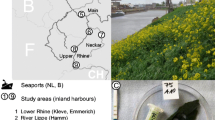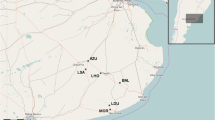Abstract
In Switzerland, the cultivation of genetically modified (GM) oilseed rape (Brassica napus L.) and the use of its seeds for food and feed are not permitted. Nevertheless, the GM oilseed rape events GT73, MS8×RF3, MS8 and RF3 have recently been found in the Rhine port of Basel, Switzerland. The sources of GM oilseed rape seeds have been unknown. The main agricultural good being imported at the Rhine port of Basel is wheat and from 2010 to 2013, 19 % of all Swiss wheat imports originated from Canada. As over 90 % of all oilseed rape grown in Canada is GM, we hypothesised that imports of Canadian wheat may contain low level impurities of GM oilseed rape. Therefore, waste fraction samples gathered during the mechanical cleaning of Canadian wheat from two Swiss grain mills were analysed by separating oilseed rape seeds from waste fraction samples and testing DNA of pooled seeds for the presence of transgenes by real-time PCR. Furthermore, oilseed rape seeds from each grain mill were sown in a germination experiment, and seedling DNA was tested for the presence of transgenes by real-time PCR. GT73, MS8×RF3, MS8 and RF3 oilseed rape was detected among seed samples and seedlings of both grain mills. Based on this data, we projected a mean proportion of 0.005 % of oilseed rape in wheat imported from Canada. Besides Canadian wheat, the Rhine port of Basel does not import any other significant amounts of agricultural products from GM oilseed rape producing countries. We therefore conclude that Canadian wheat is the major source of unintended introduction of GM oilseed rape seeds into Switzerland.
Similar content being viewed by others
References
Baxter D, Copeland LO (2008) Seed purity and taxonomy. Michigan State University Press, East Lansing
Canola Council of Canada (2014a) Canola grower's manual: Chapter 2: Canola varieties. http://www.canolacouncil.org/crop-production/canola-grower's-manual-contents. Accessed 16 February 2015
Canola Council of Canada (2014b) Canola grower's manual: Chapter 10: Integrated pest management. http://www.canolacouncil.org/crop-production/canola-grower's-manual-contents. Accessed 16 February 2015
Chèvre AM, Ammitzbøll H, Breckling B, Dietz-Pfeilstetter A, Eber F et al (2004) A review on interspecific gene flow from oilseed rape to wild relatives. In: den Nijs HCM, Bartsch D, Sweet J (eds) Introgression from genetically modified plants into wild relatives. CABI, Wallingford, pp 235–251
D’Hertefeldt T, Jørgensen RB, Pettersson LB (2008) Long-term persistence of GM oilseed rape in the seedbank. Biol Lett 4:314–317
Damgaard C, Kjellsson G (2005) Gene flow of oilseed rape (Brassica napus) according to isolation distance and buffer zone. Agric Ecosyst Environ 108:291–301
Demeke T, Perry DJ (2014) Low level presence of unapproved biotech materials: current status and capability of DNA-based detection methods. Can J Plant Sci 94:497–507
Demeke T, Perry DJ, Scowcroft WR (2006) Adventitious presence of GMOs: scientific overview for Canadian grains. Can J Plant Sci 86:1–23
Elling B, Neuffer B, Bleeker W (2009) Sources of genetic diversity in feral oilseed rape (Brassica napus) populations. Basic Appl Ecol 10:544–553
European Commission (2011) Commission regulation No. 619/2011 of 24 June 2011 laying down the methods of sampling and analysis for the official control of feed as regards presence of genetically modified material for which an authorisation procedure is pending or the authorisation of which has expired. http://eur-lex.europa.eu/LexUriServ/LexUriServ.do?uri=OJ:L:2011:166:0009:0015:EN:PDF. Accessed 16 February 2015
European Commission (2015) EU Register of authorised GMOs: genetically modified oilseed rape. http://ec.europa.eu/food/dyna/gm_register/index_en.cfm. Accessed 19 May 2015
FASC The Federal Authorities of the Swiss Confederation (2001) Swiss food manual SLMB, 2001 edn. Eidgenössische Drucksachen und Materialzentrale. http://www.slmb.bag.admin.ch/slmb/index.html. Accessed 16 February 2015
FASC The Federal Authorities of the Swiss Confederation (2003) Bundesgesetz über die Gentechnik im Ausserhumanbereich (Gentechnikgesetz, GTG) vom 21. März 2003 (Stand am 1. Juni 2014). http://www.admin.ch/ch/d/sr/8/814.91.de.pdf. Accessed 16 February 2015
FASC The Federal Authorities of the Swiss Confederation (2005) Verordnung des EDI über gentechnisch veränderte Lebensmittel (VGVL) vom 23. November 2005 (Stand am 1. Januar 2014). http://www.admin.ch/opc/de/classified-compilation/20050176/201401010000/817.022.51.pdf. Accessed 16 February 2015
FASC The Federal Authorities of the Swiss Confederation (2008) Verordnung über den Umgang mit Organismen in der Umwelt (Freisetzungsverordnung, FrSV) vom 10. September 2008 (Stand am 1. Juni 2012). http://www.admin.ch/ch/d/sr/8/814.911.de.pdf. Accessed 16 February 2015
FASC The Federal Authorities of the Swiss Confederation (2011) Verordnung über die Produktion und das Inverkehrbringen von Futtermitteln (Futtermittel-Verordnung) vom 26. Oktober 2011 (Stand am 1. Juli 2013). http://www.admin.ch/ch/d/sr/9/916.307.de.pdf. Accessed 16 February 2015
FASC The Federal Authorities of the Swiss Confederation (2014) Interpretationshilfe der Artikel 62 und 68 der Futtermittel-Verordnung vom 29.http://www.blw.admin.ch/themen/00011/01581/index.html?lang=de&download=NHzLpZeg7t,lnp6I0NTU042l2Z6ln1acy4Zn4Z2qZpnO2Yuq2Z6gpJCEeHx4fWym162epYbg2c_JjKbNoKSn6A--. Accessed 24 March 2015
FSVO The Federal Food Safety and Veterinary Office (2013) Gesuche und Bewilligungen für GVO-Erzeugnisse. http://www.blv.admin.ch/themen/04678/04817/04833/04840/index.html?lang=de. Accessed 21 May 2015
Gruber S, Pekrun C, Claupein W (2004) Seed persistence of oilseed rape (Brassica napus): variation in transgenic and conventionally bred cultivars. J Agric Sci 142:29–40
Hecht M, Oehen B, Schulze J, Brodmann P, Bagutti C (2014) Detection of feral GT73 transgenic oilseed rape (Brassica napus) along railway lines on entry routes to oilseed factories in Switzerland. Environ Sci Pollut Res 21:1455–1465
Hüsken A, Dietz-Pfeilstetter A (2007) Pollen-mediated intraspecific gene flow from herbicide resistant oilseed rape (Brassica napus L.). Trans Res 16:557–569
Jacchia S, Bogni A, Mazzara M, Kreysa J (2014) Event-specific method for the quantification of oilseed rape DP-073496-4 using real-time PCR. European Union Reference Laboratory for GM Food and Feed. http://gmo-crl.jrc.ec.europa.eu/summaries/EURL-VL-02-12VR-EFSA-Corr1.pdf. Accessed 16 February 2015
James C (2010) Global status of commercialized biotech/GM crops: 2009. ISAAA, Ithaca
James C (2011) Global status of commercialized biotech/GM crops: 2010. ISAAA, Ithaca
James C (2012) Global status of commercialized biotech/GM crops: 2011. ISAAA, Ithaca
James C (2013) Global status of commercialized biotech/GM crops: 2012. ISAAA, Ithaca
James C (2014) Global status of commercialized biotech/GM crops: 2013. ISAAA, Ithaca
Jørgensen T, Hauser TP, Jørgensen RB (2007) Adventitious presence of other varieties in oilseed rape (Brassica napus) from seed banks and certified seed. Seed Sci Res 17:115–125
Laube I, Hird H, Brodmann P, Ullmann S, Schöne-Michling M, Chisholm J, Broll H (2010) Development of primer and probe sets for the detection of plant species in honey. Food Chem 118:979–986
Lawson AN, Van Acker RC, Friesen LF (2006) Emergence timing of volunteer canola in spring wheat fields in Manitoba. Weed Sci 54:873–882
Liu Y, Wei W, Ma K, Li J, Liang Y, Darmency H (2013) Consequences of gene flow between oilseed rape (Brassica napus) and its relatives. Plant Sci 211:42–51
Mazzara M (2011a) Event-specific method for the quantification of oilseed rape MS1 using real-time PCR. European Union Reference Laboratory for GM Food and Feed. http://gmo-crl.jrc.ec.europa.eu/summaries/CRLVL1104%20VP.pdf. Accessed 16 February 2015
Mazzara M (2011b) Event-specific method for the quantification of oilseed rape RF1 using real-time PCR. European Union Reference Laboratory for GM Food and Feed. http://gmo-crl.jrc.ec.europa.eu/summaries/CRLVL0904%20VP.pdf. Accessed 16 February 2015
Mazzara M (2011c) Event-specific method for the quantification of oilseed rape RF2 using real-time PCR. European Union Reference Laboratory for GM Food and Feed. http://gmo-crl.jrc.ec.europa.eu/summaries/Rf2%20Validated%20Method%20Protocol%20CRL-VL-1004.pdf. Accessed 16 February 2015
Mazzara M, Grazioli E, Savini C, Van den Eede G (2007) Verification of performance of Ms8 and Rf3 event-specific methods on the hybrid Ms8xRf3 using real-time PCR. European Commission, Institute for Health and Consumer Protection. http://publications.jrc.ec.europa.eu/repository/handle/111111111/5658. Accessed 16 February 2015
Pascher K, Macalka S, Rau D, Gollmann G, Reiner H, Glössl J, Grabherr G (2010) Molecular differentiation of commercial varieties and feral populations of oilseed rape (Brassica napus L.). BMC Evol Biol 10:63
Port of Switzerland (2015) Statistics and bulletins. http://www.portofbasel.ch/en/news-wissenswertes/statistik-und-bulletins.php. Accessed 3 February 2015
Schoenenberger N, D'Andrea L (2012) Surveying the occurrence of subspontaneous glyphosate-tolerant genetically engineered Brassica napus L. (Brassicaceae) along Swiss railways. Environ Sci Eur 24:23
Schulze J, Frauenknecht T, Brodmann P, Bagutti C (2014) Unexpected diversity of feral genetically modified oilseed rape (Brassica napus L.) despite a cultivation and import ban in Switzerland. PLoS ONE 9:e114477. doi:10.1371/journal.pone.0114477
SBV Schweizer Bauernverband (2011) Statistische Erhebungen und Schätzungen über Landwirtschaft und Ernährung, 2010. Schweizer Bauernverband, Brugg
SBV Schweizer Bauernverband (2012) Statistische Erhebungen und Schätzungen über Landwirtschaft und Ernährung, 2011. Schweizer Bauernverband, Brugg
SBV Schweizer Bauernverband (2013) Statistische Erhebungen und Schätzungen über Landwirtschaft und Ernährung, 2012. Schweizer Bauernverband, Brugg
SBV Schweizer Bauernverband (2014) Statistische Erhebungen und Schätzungen über Landwirtschaft und Ernährung, 2013. Schweizer Bauernverband, Brugg
Tamis WLM, de Jong TJ (2009) Transport chains and seed spillage of potential GM crops with wild relatives in the Netherlands. Bilthoven, The Netherlands. http://www.cogem.net/index.cfm/en/publications/publicatie/transport-chains-and-seed-spillage-of-potential-gm-crops-with-relatives-in-te-netherlands . Accessed 10 March 2015
Weber EA, Gruber S, Claupein W (2014) Emergence and performance of volunteer oilseed rape (Brassica napus) in different crops. Eur J Agron 60:33–40
Zeitler R, Pietsch K, Waiblinger HU (2002) Validation of real-time PCR methods for the quantification of transgenic contaminations in rape seed. Eur Food Res Technol 214:346–351
Acknowledgments
This work was funded by the Federal Office for the Environment (FOEN) in Switzerland. We thank Jowa and Swissmill for their collaboration and the providing of samples. We are grateful to Dr. Fabienne Wichmann (State Laboratory Basel-City) for critical reading and helpful comments on the manuscript.
Author information
Authors and Affiliations
Corresponding author
Additional information
Responsible editor: Philippe Garrigues
Rights and permissions
About this article
Cite this article
Schulze, J., Brodmann, P., Oehen, B. et al. Low level impurities in imported wheat are a likely source of feral transgenic oilseed rape (Brassica napus L.) in Switzerland. Environ Sci Pollut Res 22, 16936–16942 (2015). https://doi.org/10.1007/s11356-015-4903-y
Received:
Accepted:
Published:
Issue Date:
DOI: https://doi.org/10.1007/s11356-015-4903-y




